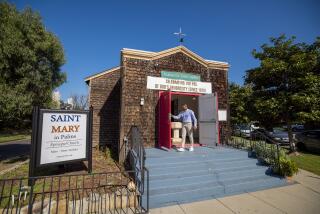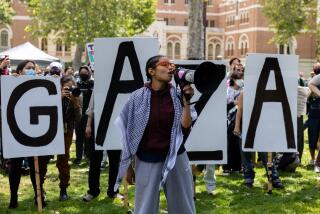Removing Obstacles to Religious Buildings
- Share via
When King Fahd of Saudi Arabia handed a local Muslim organization an $8.1-million check to build a mosque in Culver City, organizers thought their troubles were over.
In reality, problems were about to begin.
Muslim leaders became ensnared in a marathon dispute with city officials and homeowners who objected to the mosque, said Usman Madha, community liaison for the mosque. First there were complaints that increased traffic would plague the residential area. Then there were concerns about the Islamic architecture and whether lavish marble would create a glare during the daytime.
And what about that minaret? some asked. Would it be appropriate to have that tower lighted at night?
The mosque eventually opened: It celebrates its one-year anniversary this month and relations with neighbors have been good, Madha said. But the opening came only after the mosque made a number of concessions, including a 370-person limit on the number of worshipers at any one time.
The problems the mosque faced are not uncommon. In the past 10 years, zoning conflicts involving houses of worship have become contentious across Southern California.
“As religious communities, we do encounter situations, not imposed by cities themselves but by people who reside in the area. They have certain prejudices and they bring these issues up to give the city a headache,” Madha said.
Now, religious communities are likely to get more clout for handling such situations. A bill that passed both houses of Congress unanimously last week would make it more difficult for cities to use zoning laws to keep churches, temples and mosques out of their neighborhoods. President Clinton is expected to sign it into law.
Another portion of the bill seeks to ensure that people in institutions, such as mental hospitals and prisons, can freely practice their faith as long as it does not undermine security, discipline or order in their institutions.
Rep. Charles T. Canady (R-Fla.), the chief House sponsor of the bill, said some city officials would deliberately exclude all new churches from an entire city. Other cities have refused to permit churches to use existing buildings that nonreligious groups previously used and still others intentionally change zoning rules to exclude churches.
Under the new bill, local zoning and land use regulations would not be allowed to “place a substantial burden on the exercise of religion” unless municipal officials could demonstrate a “compelling government reason” to justify their actions.
The law “will give leverage to religious groups which we never had before,” Madha said.
His words were echoed by Phil Baum, president of the American Jewish Congress. The new law “provides important protection for the right to practice religion free of unjustifiable governmental interference,” Baum said in a statement. “It is a first step to restoring religious liberty to its pride of place.”
A coalition of more than 60 religious and legal advocacy groups, both liberal and conservative, banded together in support of the bill. Supporters included the American Jewish Congress, the National Assn. of Evangelicals, the Christian Legal Society, the Baptist Joint Committee, Americans United for Separation of Church and State, the Family Research Council, People for the American Way, the American Civil Liberties Union and the Church of Jesus Christ of Latter-day Saints, more commonly known as the Mormon Church.
Supporters of the bill charged that zoning officials often interfere with religious practice in ways that are discriminatory.
The new bill is designed to replace an earlier law, signed by Clinton in 1993, called the Religious Freedom Restoration Act. The Supreme Court struck that act down in 1997, saying that it went too far in siding with churches against municipal officials. The Religious Land Use and Institutionalized Persons Act is an attempt to answer that decision.
Across Southern California, there have been numerous controversies:
* Last month, Irvine residents became upset when University Synagogue announced plans to convert an ice skating rink into a temple. Protesters circulated petitions that displayed the words “University Synagogue” with a circle and slash through them and called on the City Council to rezone the property to prohibit churches.
* In July 1999, Shalom Alliance Fellowship, a small Christian congregation of Filipino and Chinese immigrants, was ousted from its storefront church in Fountain Valley because the location was in a commercial zone where churches are prohibited. The congregation filed suit, saying the city followed discriminatory policies that allowed secular groups to operate in commercial zones, but not churches. In response, the city ended its ban on churches.
* In March 1999, Morning Star Christian Church filed suit against Rolling Hills Estates after the city denied the group permission to operate in a vacant movie theater and banned churches in commercial zones.
* In 1990, Muslims in the San Fernando Valley received approval to build the $2.2-million Islamic Center in Northridge. A building permit was granted, but with 44 restrictions, the most conditions ever placed on a house of worship in San Fernando Valley. In addition to neighborhood concerns about traffic and parking, city officials pressured the Islamic Center to build the mosque without the traditional Islamic dome and insisted on a Spanish-style structure to fit the Granada Hills neighborhood. That design was publicly lamented by then-mayor Tom Bradley, who accused the City Council of religious intolerance.
* One of the most heated disputes unfolded when Congregation Etz Chaim, a small Orthodox synagogue, was ordered to stop holding services inside a Hancock Park home. The City Council rejected the congregation’s request for a special permit to remain in a residential zone. The congregation filed a federal lawsuit in 1997, accusing the city of violating members’ religious rights. The lawsuit is pending before an appellate court.
Testifying before the House Judiciary Committee on the issue last year, the congregation’s rabbi, Chaim Baruch Rubin, said, “Local zoning laws are being used as latter-day restrictive covenants, making it essentially impossible for Orthodox Jews to live in Hancock Park.”
It is not clear to religious leaders why opposition almost always arises when houses of worship are involved. Commonly, homeowners cite increased traffic, building size and other nonreligious issues as primary concerns. The Rev. Isaac J. Canales, president of the Latin American Bible Institute in La Puente, says the underlying argument is money and churches’ exemption from paying property taxes.
“Let’s face it: Cities survive on revenue, and you can’t blame them for that,” said Canales, who is also pastor of Mission Eben-Ezer Family Church in Carson. “On the other hand, when a church service ends, the city has 1,500 people looking for a place to eat, a place to shop, a place to buy gas. That’s a significant influx of money generated from a religious community.”
Canales called on churches to become more active in their communities so city officials and homeowners will have less reason to object.
“If the church is a contributor to the community, it is always a positive influence,” he said.
More to Read
Sign up for Essential California
The most important California stories and recommendations in your inbox every morning.
You may occasionally receive promotional content from the Los Angeles Times.










